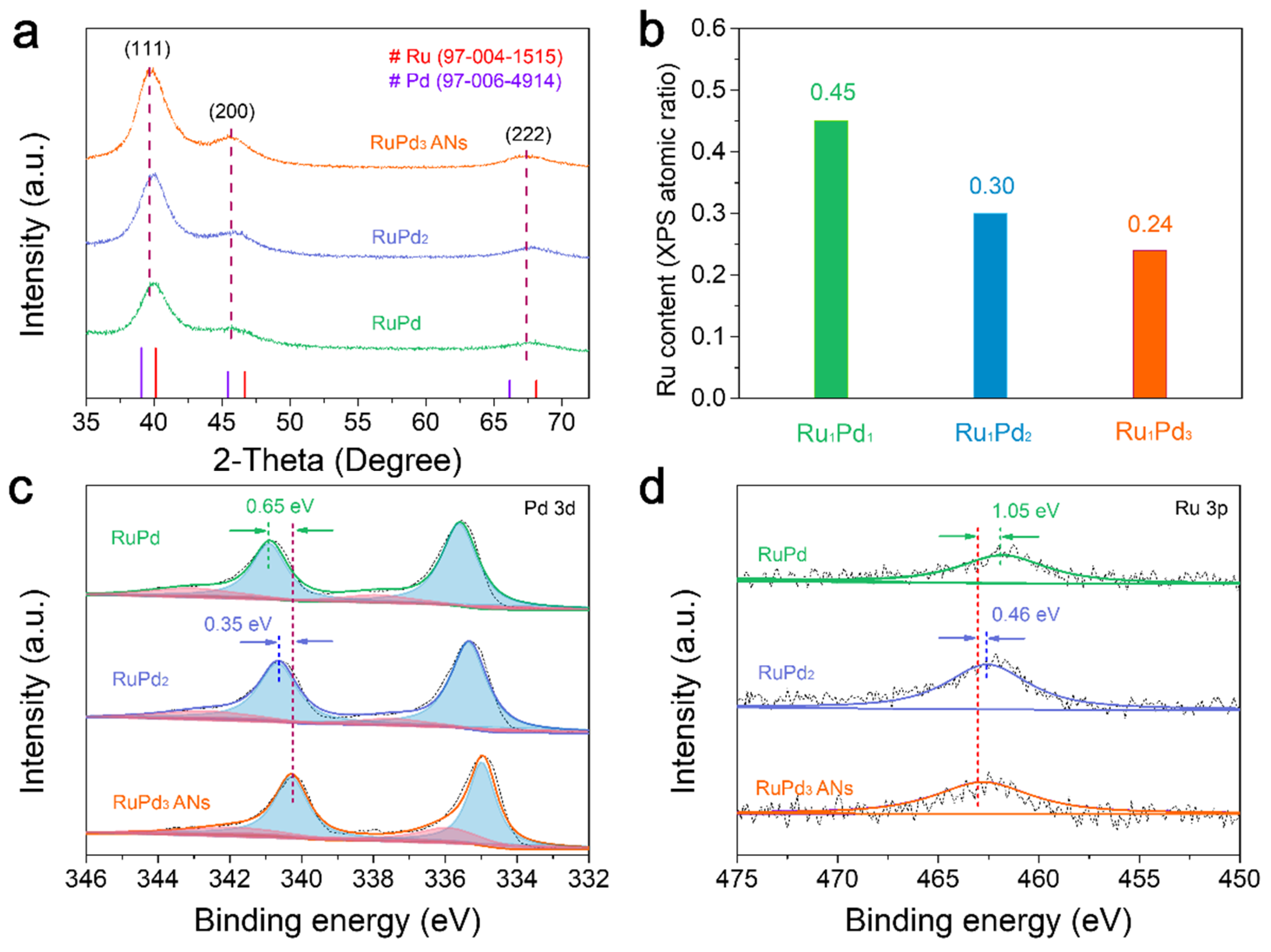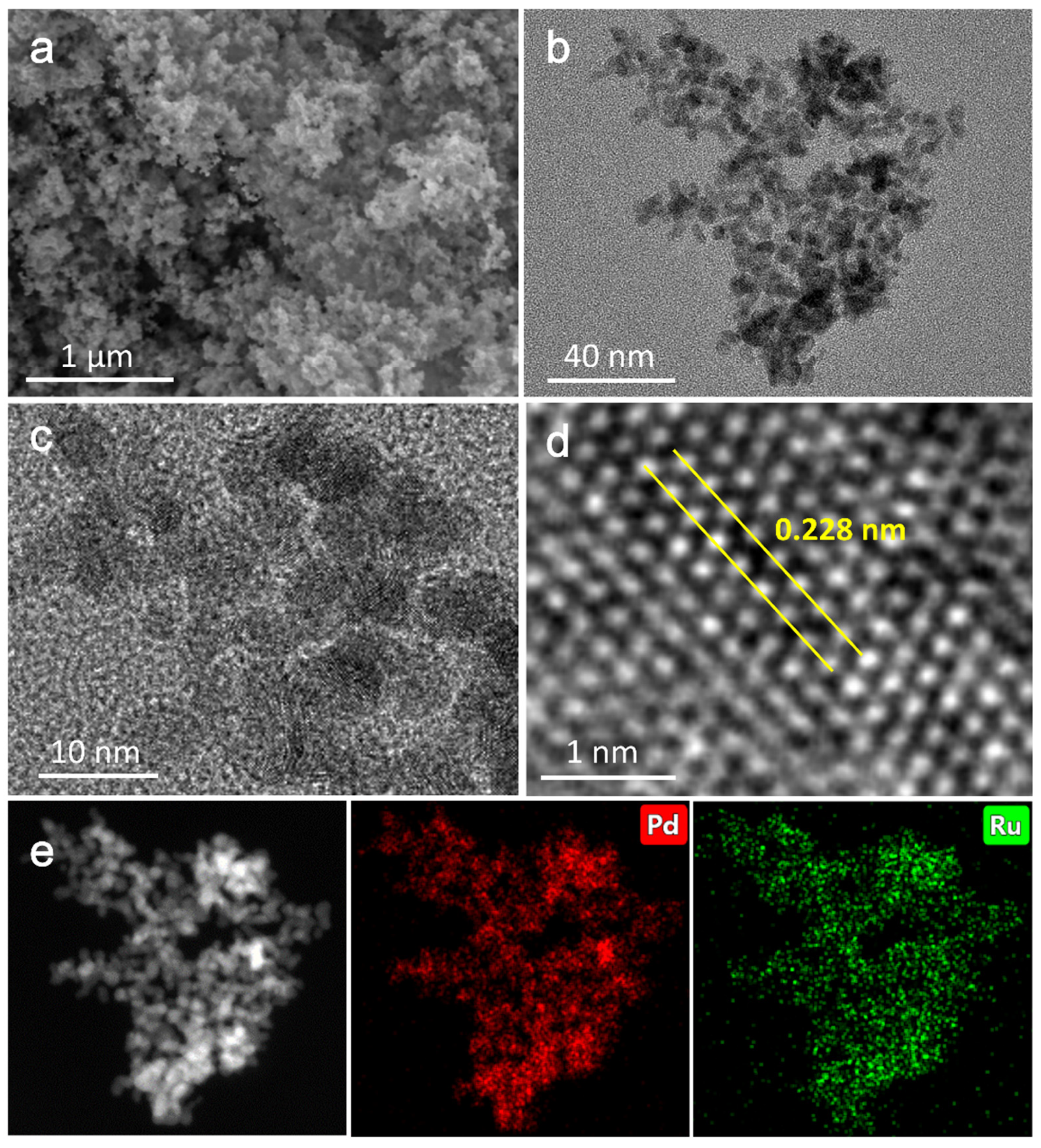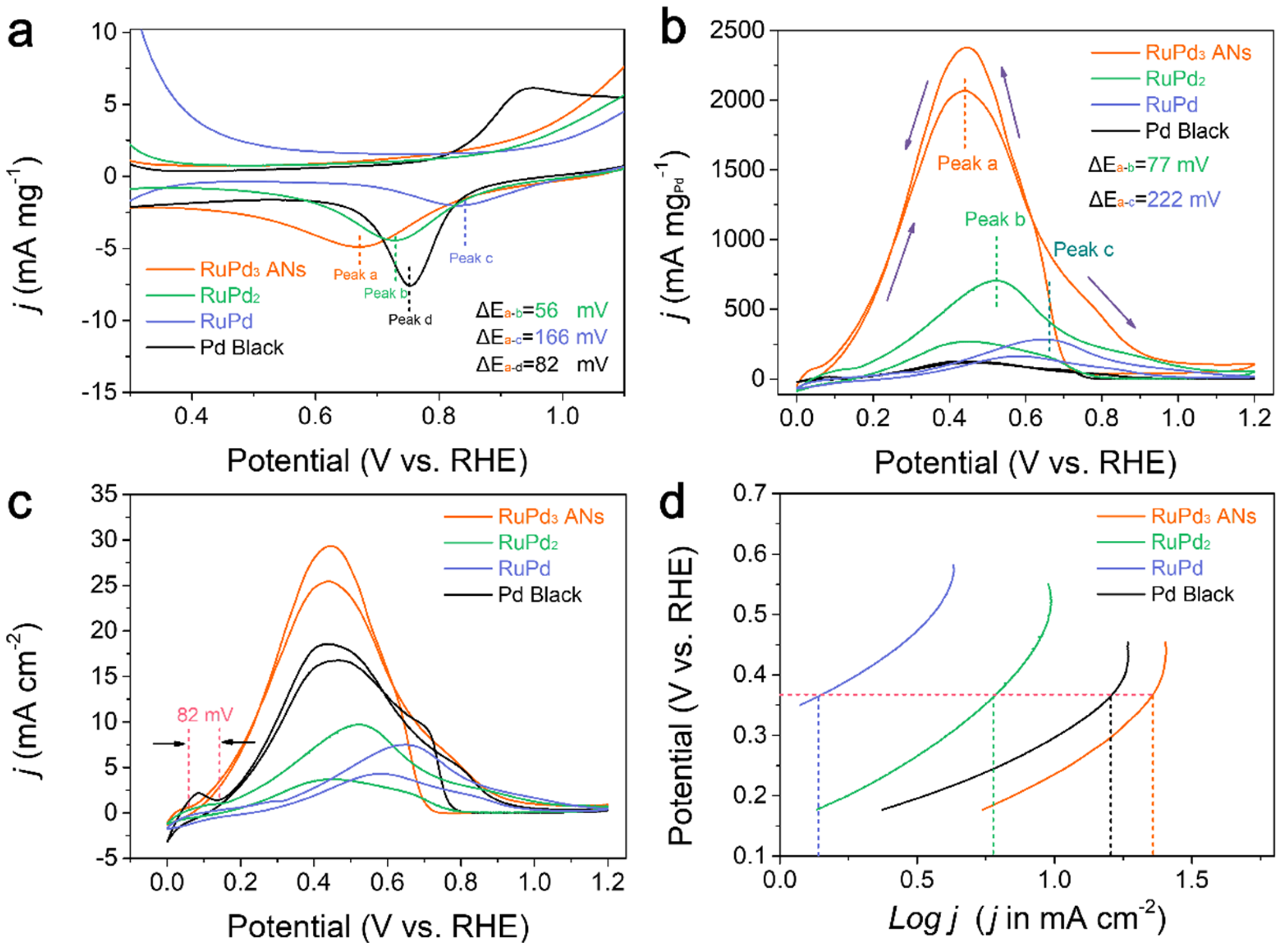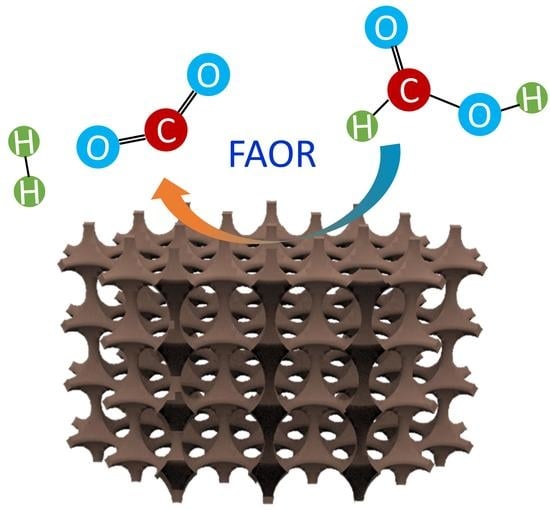Cyanogel-Induced Synthesis of RuPd Alloy Networks for High-Efficiency Formic Acid Oxidation
Abstract
:1. Introduction
2. Results and Discussion
2.1. Physical Characterisation of Pdx [Ru(CN)6]y·aH2O Cyanogels
2.2. Physical Characterisation of As-Prepared RuPd3 ANs, RuPd2 and RuPd
2.3. Microscopic Morphological Characterisation
2.4. Electrochemical Analysis
3. Materials and Methods
3.1. Electrochemical Analysis
3.2. Methods—Synthesis of RuPdx Alloy Networks
3.3. Characterisation
3.4. Electrochemical Measurements
4. Conclusions
Supplementary Materials
Author Contributions
Funding
Data Availability Statement
Acknowledgments
Conflicts of Interest
References
- Lv, F.; Zhang, W.; Sun, M.; Lin, F.; Wu, T.; Zhou, P.; Yang, W.; Gao, P.; Huang, B.; Guo, S. Au Clusters on Pd Nanosheets Selectively Switch the Pathway of Ethanol Electrooxidation: Amorphous/Crystalline Interface Matters. Adv. Energy Mater. 2021, 11, 2100187. [Google Scholar] [CrossRef]
- Yang, L.; Li, G.; Chang, J.; Ge, J.; Liu, C.; Vladimir, F.; Wang, G.; Jin, Z.; Xing, W. Sea urchin-like Aucore@Pdshell electrocatalysts with high FAOR performance: Coefficient of lattice strain and electrochemical surface area. Appl. Catal. B 2020, 260, 118200. [Google Scholar] [CrossRef]
- Feng, L.; Cui, Z.; Yan, L.; Xing, W.; Liu, C. The enhancement effect of MoOx on Pd/C catalyst for the electrooxidation of formic acid. Electrochim. Acta 2011, 56, 2051–2056. [Google Scholar] [CrossRef]
- Zhang, J.; Wu, L.; Xu, L.; Sun, D.; Sun, H.; Tang, Y. Recent advances in phosphorus containing noble metal electrocatalysts for direct liquid fuel cells. Nanoscale 2021, 13, 16052–16069. [Google Scholar] [CrossRef] [PubMed]
- Jiao, K.; Xuan, J.; Du, Q.; Bao, Z.; Xie, B.; Wang, B.; Zhao, Y.; Fan, L.; Wang, H.; Hou, Z.; et al. Designing the next generation of proton-exchange membrane fuel cells. Nature 2021, 595, 361–369. [Google Scholar] [CrossRef]
- Wang, T.; Jiang, Y.; He, J.; Li, F.; Ding, Y.; Chen, P.; Chen, Y. Porous palladium phosphide nanotubes for formic acid electrooxidation. Carbon Energy 2022, 4, 283–293. [Google Scholar] [CrossRef]
- Wang, Y.; Jiang, X.; Fu, G.; Li, Y.; Tang, Y.; Lee, J.; Tang, Y. Cu5Pt Dodecahedra with Low-Pt Content: Facile Synthesis and Outstanding Formic Acid Electrooxidation. ACS Appl. Mater. Interfaces 2019, 11, 34869–34877. [Google Scholar] [CrossRef] [PubMed]
- Meng, Q.; Yang, X.; Wang, X.; Xiao, M.; Li, K.; Jin, Z.; Ge, J.; Liu, C.; Xing, W. Preparation Strategy Using Pre-Nucleation Coupled with In Situ Reduction for a High-Performance Catalyst towards Selective Hydrogen Production from Formic Acid. Catalysts 2022, 12, 325. [Google Scholar] [CrossRef]
- Ma, Z.; Legrand, U.; Pahija, E.; Tavares, J.R.; Boffito, D.C. From CO2 to Formic Acid Fuel Cells. Ind. Eng. Chem. Res. 2020, 60, 803–815. [Google Scholar] [CrossRef]
- Hossain, S.K.S.; Alwi, M.M.; Saleem, J.; Al-Hashem, H.T.; McKay, G.; Mansour, S.; Ali, S.S. Bimetallic Pd-Co Nanoparticles Supported on Nitrogen-Doped Reduced Graphene Oxide as Efficient Electrocatalysts for Formic Acid Electrooxidation. Catalysts 2021, 11, 910. [Google Scholar] [CrossRef]
- Teng, Z.; Li, M.; Li, Z.; Liu, Z.; Fu, G.; Tang, Y. Facile synthesis of channel-rich ultrathin palladium-silver nanosheets for highly efficient formic acid electrooxidation. Mater. Today Energy 2021, 19, 100596. [Google Scholar] [CrossRef]
- Fang, Z.; Chen, W. Recent advances in formic acid electro-oxidation: From the fundamental mechanism to electrocatalysts. Nanoscale Adv. 2021, 3, 94–105. [Google Scholar] [CrossRef] [PubMed]
- Rettenmaier, C.; Aran-Ais, R.; Timoshenko, J.; Rizo, R.; Jeon, H.; Kuhl, S.; Chee, S.; Bergmann, A.; Cuenya, B.R. Enhanced Formic Acid Oxidation over SnO2-decorated Pd Nanocubes. ACS Catal. 2020, 10, 14540–14551. [Google Scholar] [CrossRef] [PubMed]
- Chang, J.; Feng, L.; Liu, C.; Xing, W.; Hu, X. An effective Pd-Ni(2)P/C anode catalyst for direct formic acid fuel cells. Angew. Chem. Int. Ed. 2014, 53, 122–126. [Google Scholar] [CrossRef]
- Bhaskaran, R.; Abraham, B.G.; Chetty, R. Recent advances in electrocatalysts, mechanism, and cell architecture for direct formic acid fuel cells. WIREs Energy Environ. 2021, 11, e419. [Google Scholar] [CrossRef]
- Liu, Q.; Wang, J.; Zhang, J.; Yan, Y.; Qiu, X.; Wei, S.; Tang, Y. In situ immobilization of isolated Pd single-atoms on graphene by employing amino-functionalized rigid molecules and their prominent catalytic performance. Catal. Sci. Technol. 2020, 10, 450–457. [Google Scholar] [CrossRef]
- Chen, D.; Pei, S.; He, Z.; Shao, H.; Wang, J.; Wang, K.; Wang, Y.; Jin, Y. High Active PdSn Binary Alloyed Catalysts Supported on B and N Codoped Graphene for Formic Acid Electro-Oxidation. Catalysts 2020, 10, 751. [Google Scholar] [CrossRef]
- Jiang, X.; Xiong, Y.; Wang, Y.; Wang, J.; Li, N.; Zhou, J.; Fu, G.; Sun, D.; Tang, Y. Treelike two-level PdxAgy nanocrystals tailored for bifunctional fuel cell electrocatalysis. J. Mater. Chem. A 2019, 7, 5248–5257. [Google Scholar] [CrossRef]
- Xia, B.; Wu, H.; Yan, Y.; Wang, H.; Wang, X. One-pot synthesis of platinum nanocubes on reduced graphene oxide with enhanced electrocatalytic activity. Small 2014, 10, 2336–2339. [Google Scholar] [CrossRef]
- Ye, S.; Feng, J.; Li, G. Pd Nanoparticle/CoP Nanosheet Hybrids: Highly Electroactive and Durable Catalysts for Ethanol Electrooxidation. ACS Catal. 2016, 6, 7962–7969. [Google Scholar] [CrossRef]
- Peng, L.; Wei, Z. Catalyst Engineering for Electrochemical Energy Conversion from Water to Water: Water Electrolysis and the Hydrogen Fuel Cell. Engineering 2020, 6, 653–679. [Google Scholar] [CrossRef]
- Yu, H.; Zhou, T.; Wang, Z.; Xu, Y.; Li, X.; Wang, L.; Wang, H. Defect-Rich Porous Palladium Metallene for Enhanced Alkaline Oxygen Reduction Electrocatalysis. Angew. Chem. Int. Ed. 2021, 60, 12027–12031. [Google Scholar] [CrossRef] [PubMed]
- Zhang, L.; Wang, F.; Wang, S.; Huang, H.; Meng, X.; Ouyang, Y.; Yuan, W.; Guo, C.; Li, C. Layered and Heterostructured Pd/PdWCr Sheet–Assembled Nanoflowers as Highly Active and Stable Electrocatalysts for Formic Acid Oxidation. Adv. Funct. Mater. 2020, 30, 2003933. [Google Scholar] [CrossRef]
- Xia, B.; Chen, Y. Preface to special issue on electrocatalysis for sustainable energy. Chin. J. Catal. 2022, 43, 1379. [Google Scholar] [CrossRef]
- Wang, X.; Tang, Y.; Lee, J.; Fu, G. Recent advances in rare-earth-based materials for electrocatalysis. Chem. Catal. 2022, 2, 967–1008. [Google Scholar] [CrossRef]
- Wang, X.; Zhu, Y.; Li, H.; Lee, M.; Tang, Y.; Fu, G. Rare-Earth Single-Atom Catalysts: A New Frontier in Photo/Electrocatalysis. Small Methods 2022, 6, 2200413. [Google Scholar] [CrossRef]
- Wang, X.; Wang, J.; Wang, P.; Li, L.; Zhang, X.; Sun, D.; Li, Y.; Tang, Y.; Wang, Y.; Fu, G. Engineering 3d-2p-4f Gradient Orbital Coupling to Enhance Electrocatalytic Oxygen Reduction. Adv. Mater. 2022, 2206540. [Google Scholar] [CrossRef]
- Cao, K.; Yang, H.; Bai, S.; Xu, Y.; Yang, C.; Wu, Y.; Xie, M.; Cheng, T.; Shao, Q.; Huang, X. Efficient Direct H2O2 Synthesis Enabled by PdPb Nanorings via Inhibiting the O–O Bond Cleavage in O2 and H2O2. ACS Catal. 2021, 11, 1106–1118. [Google Scholar] [CrossRef]
- Yan, X.; Hu, X.; Fu, G.; Xu, L.; Lee, J.; Tang, Y. Facile Synthesis of Porous Pd3Pt Half-Shells with Rich “Active Sites” as Efficient Catalysts for Formic Acid Oxidation. Small 2018, 14, e1703940. [Google Scholar] [CrossRef]
- Liu, S.; Wang, Z.; Zhang, H.; Yin, S.; Xu, Y.; Li, X.; Wang, L.; Wang, H. B-Doped PdRu nanopillar assemblies for enhanced formic acid oxidation electrocatalysis. Nanoscale 2020, 12, 19159–19164. [Google Scholar] [CrossRef]
- Ren, J.; Yao, Y.; Yuan, Z. Fabrication strategies of porous precious-metal-free bifunctional electrocatalysts for overall water splitting: Recent advances. Green Energy Environ. 2021, 6, 620–643. [Google Scholar] [CrossRef]
- Li, Z.; Li, M.; Wang, X.; Fu, G.; Tang, Y. The use of amino-based functional molecules for the controllable synthesis of noble-metal nanocrystals: A minireview. Nanoscale Adv. 2021, 3, 1813–1829. [Google Scholar] [CrossRef]
- Zaman, S.; Tian, X.; Su, Y.; Cai, W.; Yan, Y.; Qi, R.; Douka, A.; Chen, S.; You, B.; Liu, H.; et al. Direct integration of ultralow-platinum alloy into nanocarbon architectures for efficient oxygen reduction in fuel cells. Sci. Bull. 2021, 66, 2207–2216. [Google Scholar] [CrossRef]
- Zhang, H.; Wang, H.; Xu, Y.; Zhuo, S.; Yu, Y.; Zhang, B. Conversion of Sb2Te3 hexagonal nanoplates into three-dimensional porous single-crystal-like network-structured Te plates using oxygen and tartaric acid. Angew. Chem. Int. Ed. 2012, 51, 1459–1463. [Google Scholar] [CrossRef] [PubMed]
- Wang, D.; Jiang, X.; Lin, Z.; Zeng, X.; Zhu, Y.; Wang, Y.; Gong, M.; Tang, Y.; Fu, G. Ethanol-Induced Hydrogen Insertion in Ultrafine IrPdH Boosts pH-Universal Hydrogen Evolution. Small 2022, 18, 2204063. [Google Scholar] [CrossRef]
- Lin, S.; Yao, Y.; Zhang, L.; Feng, J.; Wang, J. Cyanogel and its derived-materials: Properties, preparation methods, and electrochemical applications. Mater. Today Energy 2021, 20, 100701. [Google Scholar] [CrossRef]
- Wan, J.; Liu, Z.; Yang, X.; Cheng, P.; Yan, C. Cyanogel-Derived Synthesis of Porous PdFe Nanohydrangeas as Electrocatalysts for Oxygen Reduction Reaction. Nanomaterials 2021, 11, 3382. [Google Scholar] [CrossRef]
- Burgess, C.M.; Yao, N.; Bocarsly, A.B. Stabilizing cyanosols: Amorphous cyanide bridged transition metal polymer nanoparticles. J. Mater. Chem. 2009, 19, 8846–8855. [Google Scholar] [CrossRef]
- Liu, X.; Xu, G.; Chen, Y.; Lu, T.; Tang, Y.; Xing, W. A strategy for fabricating porous PdNi@Pt core-shell nanostructures and their enhanced activity and durability for the methanol electrooxidation. Sci. Rep. 2015, 5, 7619. [Google Scholar] [CrossRef]
- Liu, H.; Liu, X.; Li, Y.; Jia, Y.; Tang, Y.; Chen, Y. Hollow PtNi alloy nanospheres with enhanced activity and methanol tolerance for the oxygen reduction reaction. Nano Res. 2016, 9, 3494–3503. [Google Scholar] [CrossRef]
- Liu, Z.; Yang, X.; Cui, L.; Shi, Z.; Lu, B.; Guo, X.; Zhang, J.; Xu, L.; Tang, Y.; Xiang, Y. High-Performance Oxygen Reduction Electrocatalysis Enabled by 3D PdNi Nanocorals with Hierarchical Porosity. Part. Part. Syst. Charact. 2018, 35, 1700366. [Google Scholar] [CrossRef]
- Bai, J.; Xue, Q.; Zhao, Y.; Jiang, J.; Zeng, J.; Yin, S.; Chen, Y. Component-Dependent Electrocatalytic Activity of Ultrathin PdRh Alloy Nanocrystals for the Formate Oxidation Reaction. ACS Sustain. Chem. Eng. 2018, 7, 2830–2836. [Google Scholar] [CrossRef]
- Liu, X.; Zhang, Y.; Gong, M.; Tang, Y.; Lu, T.; Chen, Y.; Lee, J. Facile synthesis of corallite-like Pt–Pd alloy nanostructures and their enhanced catalytic activity and stability for ethanol oxidation. J. Mater. Chem. A 2014, 2, 13840–13844. [Google Scholar] [CrossRef]
- Liu, Q.; Li, Z.; Zhou, X.; Xiao, J.; Han, Z.; Jiang, X.; Fu, G.; Tang, Y. Cyanogel--Induced PdCu Alloy with Pd–Enriched Surface for Formic Acid Oxidation and Oxygen Reduction. Adv. Energy Sustain. Res. 2022, 2200067. [Google Scholar] [CrossRef]
- Liu, Z.; Yang, X.; Lu, B.; Shi, Z.; Sun, D.; Xu, L.; Tang, Y.; Sun, S. Delicate topotactic conversion of coordination polymers to Pd porous nanosheets for high-efficiency electrocatalysis. Appl. Catal. B 2019, 243, 86–93. [Google Scholar] [CrossRef]
- Shi, H.; Fang, Z.; Zhang, X.; Li, F.; Tang, Y.; Zhou, Y.; Wu, P.; Yu, G. Double-Network Nanostructured Hydrogel-Derived Ultrafine Sn-Fe Alloy in Three-Dimensional Carbon Framework for Enhanced Lithium Storage. Nano Lett. 2018, 18, 3193–3198. [Google Scholar] [CrossRef]
- Liu, H.; Li, J.; Wang, L.; Tang, Y.; Xia, B.Y.; Chen, Y. Trimetallic PtRhNi alloy nanoassemblies as highly active electrocatalyst for ethanol electrooxidation. Nano Res. 2017, 10, 3324–3332. [Google Scholar] [CrossRef]
- Ahmad, A.; Khan, S.; Tariq, S.; Luque, R.; Verpoort, F. Self-sacrifice MOFs for heterogeneous catalysis: Synthesis mechanisms and future perspectives. Mater. Today 2022, 55, 137–169. [Google Scholar] [CrossRef]
- Zhang, H.; Cen, K.; Wen, J.; Qi, M.; Ge, X.; Liu, Y.; Sun, D.; Tang, Y. One-Pot Synthesis of Porous Palladium Nanorods for Efficient Formic Acid Electro-Oxidation Reaction. Sci. Adv. Mater. 2017, 10, 460–466. [Google Scholar] [CrossRef]
- Zhang, L.; Sui, Q.; Tang, T.; Chen, Y.; Zhou, Y.; Tang, Y.; Lu, T. Surfactant-free palladium nanodendrite assemblies with enhanced electrocatalytic performance for formic acid oxidation. Electrochem. Commun. 2013, 32, 43–46. [Google Scholar] [CrossRef]
- Qiu, X.; Zhang, H.; Dai, Y.; Zhang, F.; Wu, P.; Wu, P.; Tang, Y. Sacrificial Template-Based Synthesis of Unified Hollow Porous Palladium Nanospheres for Formic Acid Electro-Oxidation. Catalysts 2015, 5, 992–1002. [Google Scholar] [CrossRef]
- Qiu, X.; Zhang, H.; Wu, P.; Zhang, F.; Wei, S.; Sun, D.; Xu, L.; Tang, Y. One-Pot Synthesis of Freestanding Porous Palladium Nanosheets as Highly Efficient Electrocatalysts for Formic Acid Oxidation. Adv. Funct. Mater. 2017, 27, 1603852. [Google Scholar] [CrossRef]
- Xu, L.; Wang, K.; Yuan, Q. One-pot synthesis of lotus-shaped Pd–Cu hierarchical superstructure crystals for formic acid oxidation. RSC Adv. 2016, 6, 96079–96083. [Google Scholar] [CrossRef]
- Xu, J.; Zhao, M.; Yamaura, S.-I.; Jin, T.; Asao, N. Core–shell Pd–P@Pt nanoparticles as efficient catalysts for electrooxidation of formic acid. J. Appl. Electrochem. 2016, 46, 1109–1118. [Google Scholar] [CrossRef]
- Wang, H.; Li, Y.; Li, C.; Wang, Z.; Xu, Y.; Li, X.; Xue, H.; Wang, L. Hyperbranched PdRu nanospine assemblies: An efficient electrocatalyst for formic acid oxidation. J. Mater. Chem. A 2018, 6, 17514–17518. [Google Scholar] [CrossRef]
- Yang, F.; Zhang, Y.; Liu, P.-F.; Cui, Y.; Ge, X.-R.; Jing, Q.-S. Pd–Cu alloy with hierarchical network structure as enhanced electrocatalysts for formic acid oxidation. Int. J. Hydrogen Energy 2016, 41, 6773–6780. [Google Scholar] [CrossRef]
- Shen, T.; Chen, S.; Zeng, R.; Gong, M.; Zhao, T.; Lu, Y.; Liu, X.; Xiao, D.; Yang, Y.; Hu, J.; et al. Tailoring the Antipoisoning Performance of Pd for Formic Acid Electrooxidation via an Ordered PdBi Intermetallic. ACS Catal. 2020, 10, 9977–9985. [Google Scholar] [CrossRef]
- Yang, G.; Chen, Y.; Zhou, Y.; Tang, Y.; Lu, T. Preparation of carbon supported Pd–P catalyst with high content of element phosphorus and its electrocatalytic performance for formic acid oxidation. Electrochem. Commun. 2010, 12, 492–495. [Google Scholar] [CrossRef]
- Shen, T.; Lu, Y.; Gong, M.; Zhao, T.; Hu, Y.; Wang, D. Optimizing Formic Acid Electro-oxidation Performance by Restricting the Continuous Pd Sites in Pd–Sn Nanocatalysts. ACS Sustain. Chem. Eng. 2020, 8, 12239–12247. [Google Scholar] [CrossRef]
- Xu, Y.; Yu, S.; Ren, T.; Li, C.; Yin, S.; Wang, Z.; Li, X.; Wang, L.; Wang, H. A quaternary metal–metalloid–nonmetal electrocatalyst: B, P-co-doping into PdRu nanospine assemblies boosts the electrocatalytic capability toward formic acid oxidation. J. Mater. Chem. A 2020, 8, 2424–2429. [Google Scholar] [CrossRef]
- Goswami, C.; Saikia, H.; Tada, K.; Tanaka, S.; Sudarsanam, P.; Bhargava, S.K.; Bharali, P. Bimetallic Palladium–Nickel Nanoparticles Anchored on Carbon as High-Performance Electrocatalysts for Oxygen Reduction and Formic Acid Oxidation Reactions. ACS Appl. Energy Mater. 2020, 3, 9285–9295. [Google Scholar] [CrossRef]





| Sample Name | EDS Analysis | XPS Analysis | ICP Analysis |
|---|---|---|---|
| RuPd | 0.47 | 0.45 | 0.51 |
| RuPd2 | 0.30 | 0.30 | 0.35 |
| RuPd3 | 0.12 | 0.24 | 0.23 |
Publisher’s Note: MDPI stays neutral with regard to jurisdictional claims in published maps and institutional affiliations. |
© 2022 by the authors. Licensee MDPI, Basel, Switzerland. This article is an open access article distributed under the terms and conditions of the Creative Commons Attribution (CC BY) license (https://creativecommons.org/licenses/by/4.0/).
Share and Cite
Liu, Q.; Yan, W.; Zhang, J.; Ren, Y.; Liu, J.; Zeng, X.; Sun, D.; Tang, Y. Cyanogel-Induced Synthesis of RuPd Alloy Networks for High-Efficiency Formic Acid Oxidation. Catalysts 2022, 12, 1136. https://doi.org/10.3390/catal12101136
Liu Q, Yan W, Zhang J, Ren Y, Liu J, Zeng X, Sun D, Tang Y. Cyanogel-Induced Synthesis of RuPd Alloy Networks for High-Efficiency Formic Acid Oxidation. Catalysts. 2022; 12(10):1136. https://doi.org/10.3390/catal12101136
Chicago/Turabian StyleLiu, Qicheng, Wei Yan, Jiachen Zhang, Yi Ren, Jiaqi Liu, Xin Zeng, Dongmei Sun, and Yawen Tang. 2022. "Cyanogel-Induced Synthesis of RuPd Alloy Networks for High-Efficiency Formic Acid Oxidation" Catalysts 12, no. 10: 1136. https://doi.org/10.3390/catal12101136
APA StyleLiu, Q., Yan, W., Zhang, J., Ren, Y., Liu, J., Zeng, X., Sun, D., & Tang, Y. (2022). Cyanogel-Induced Synthesis of RuPd Alloy Networks for High-Efficiency Formic Acid Oxidation. Catalysts, 12(10), 1136. https://doi.org/10.3390/catal12101136











